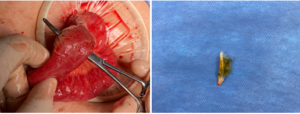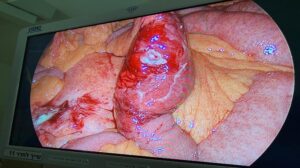Mira Damounya1, Safi Khuri1,2*
1- General Surgery, Department, Rambam Health Care Campus, Haifa, Israel
2- HPB and Surgical Oncology Unit, Rambam Health Care Campus, Haifa, Israel
*Corresponding Author: Safi Khuri, General Surgery Department, Rambam Health Care Campus, Haifa, Israel; Tel: +9725025989342; Email: [email protected]
Published Date: 07-08-2020
Copyright© 2020 by Khuri S, et al. All rights reserved. This is an open access article distributed under the terms of the Creative Commons Attribution License, which permits unrestricted use, distribution, and reproduction in any medium, provided the original author and source are credited.
Abstract
Accidental Foreign body ingestion is not an uncommon medical problem. Of all foreign bodies ingested, Fishbones are the most common, yet most pass the alimentary tract unnoticed. Gastrointestinal complications, such as hollow viscus perforation may develop in less than 1% of cases. Diagnosis is usually challenging and depends on a combination of detailed history and physical examination, along with radiological findings. Two cases of non-radio-opaque fishbone ingestion with localized small bowel perforation presented radiologically as focal enteritis are reported here.
Keywords
Fishbone Ingestion; Localized Peritonitis; Focal Enteritis
Introduction
Accidental Foreign Bodies (FBs) ingestion is a well-known, highly challenging medical problem. Most FBs pass unnoticed through the alimentary tract within 1 week [1]. Only small portion (<1%) of these bodies may cause Gastrointestinal (GI) complications, such as bowel perforation, intestinal obstruction, GI haemorrhage or abscess formation [2,3]. The cricopharyngeal sphincter of the esophagus is the most common GI site (75%) where most FBs are impacted [4]. Intra-abdominally, the most common sites of FBs impaction and complications are the less mobile segments of the bowel with acute angulation such as the ileum and the rectosegmoid junction [5]. Of all accidentally ingested FBs, fish bones are the most common with cases ranging between 63-84% [6,7].
Diagnosis of said surgical problems depends on a combination of detailed history, physical examination as well as radiological findings. Imaging studies include abdominal plain radiography and abdominopelvic Computed Tomography (CT) scan. Plain radiography has a low sensitivity and high rates of false negative findings (47%). Findings usually depend on the size and the radio-opacity of the fish bone [8,9]. On the other hand, abdominopelvic CT scan, which is regarded as the gold standard radiological study, has a higher sensitivity in detecting accidentally ingested FBs [4]. Findings on CT imaging are diverse and include localized fat stranding, localized bowel wall thickening, localized pneumoperitoneum and in some cases a hyper dense linear FB is demonstrated [5,10].
Herein, we describe two patients who presented with focal enteritis secondary to accidentally ingested fishbone.
Case 1
A 55-year-old male patient presented to our emergency department complaining of lower abdominal pain of 3 days’ duration. The pain was accompanied by fever of 38◦C. The patient denied recent accidental foreign body ingestion. His past surgical history includes laparoscopic single anastomosis gastric bypass due to morbid obesity.
Upon his admission, his vital signs were within normal limits. Abdominal examination revealed soft abdomen with localized tenderness in the lower abdomen. Complete blood count showed WBCs count of 12k. Liver and Kidney function tests were within normal limits. Abdominal X-ray was normal. Abdominal US showed cholelithiasis with no signs of cholecystitis, and thickening of bowel wall segment in left-mid abdomen. Abdominal CT scan revealed thickening of short segment of the ileum along with localized fat stranding with no signs of pneumoperitoneum (Fig. 1).
Due to these findings the patient underwent an exploratory laparoscopy which revealed a hyperaemic segment of small bowel (ileum) covered with a fibrin (Fig. 2), two parallel perforation sites of 2 mm due to a stuck 3 cm fish bone (Fig. 3) were found. An En block resection of the affected small bowel segment along with primary anastomosis was contemplated. His post-operative course was uneventful and the patient was discharged home on post-operative day 3. Histopathological report findings were positive for acute inflammation of the small bowel.

Figure 1: Abomino-Pelvic CT scan showing thickening of short segment of the ileum along (arrow) with localized fat stranding.

Figure 2: On exploratory laparoscopy, a short segment of small bowel with hyperemia covered with fibrin was noticed.

Figure 3: Two parallel perforation sites of 2 mm due to a stuck 3 cm fish bone were found.
Case 2
A 67-year-old male patient who presented to our emergency department complaining of abdominal pain of 4 days’ duration along with constipation. His past surgical history includes laparoscopic cholecystectomy due to cholelithiasis.
His vital signs upon his admission were within normal limits. His physical examination revealed soft abdomen with localized left abdominal tenderness. Complete blood count, liver and kidney tests were within normal limits. Abdominal X-ray was normal. Abdominal CT scan revealed thickening of a small bowel segment along with localized fat stranding, a findings compatible with focal enteritis.
The patient underwent an exploratory laparoscopy, during which a hyperaemic small bowel segment was identified; it was covered with a fibrin layer and pus (Fig. 4). An En block resection of the affected bowel was performed along with primary anastomosis. The resected bowel was opened and a small fish bone was demonstrated, stuck in the bowel wall causing inflammatory reaction and micro perforation (Fig. 5). His post-operative course was uneventful and he was discharged on post-operative-day 6.

Figure 4: During diagnostic Laparoscopy, a hyperaemic small bowel segment covered by fibrin was identified.

Figure 5: Upon opening the resected specimen, a small fish bone was demonstrated, stuck in the bowel wall causing inflammatory reaction and micro perforation.
Conclusion
Accidental fishbone ingestion is an uncommon surgical problem, yet highly challenging for the treating physician. High index of suspecion is warranted for correct diagnosis, which depends on a combination of detailed history and physical exam as well as radiological findings. Radiological focal segmental enteritis in patients with suitable anmenza should encourage surgical exploration by means of diagnostic laparoscopy.
References
- Ginzburg L, Beller AJ. The clinical manifestations of non-metallic perforating intestinal foreign bodies. Ann Surg 1927;86:918-39.
- Velitchkov NG, Grigorov GI, Losanoff JE, Kjossev KT. Ingested foreign bodies of the gastrointestinal tract: retrospective analysis of 542 cases. World J Surg. 1996;20(8):1001-5.
- Madrona AP, Hernández JA, Prats MC, Riquelme JR, Paricio PP. Intestinal perforation by foreign bodies. Eur J Surg. 2000;166(4):307-9.
- Bathla G, Teo LL, Dhanda S. Pictorial essay: complications of a swallowed fish bone. Indian J Radiol Imaging. 2011;21(1):63.
- Venkatesh SH, Karaddi NK. CT findings of accidental fish bone ingestion and its complications. Diagn Interv Radiol. 2016;22(2):156.
- Shivakumar AM, Naik AS, Prashanth KB, Hongal GF, Chaturvedy G. Foreign bodies in upper digestive tract. Indian J Otolaryngol Head Neck Surg. 2006;58(1):63-8.
- Goh BK, Chow PK, Quah HM, Ong HS, Eu KW, Ooi LL, et al. Perforation of the gastrointestinal tract secondary to ingestion of foreign bodies. World J Surg. 2006;30(3):372-7.
- Klein A, Ovnat-Tamir S, Marom T, Gluck O, Rabinovics N, Shemesh S. Fish bone foreign body: The role of imaging. Int Arch Otorhinolaryngol. 2019;23(1):110-5.
- Ngan JH, Fok PJ, Lai EC, Branicki FJ, Wong JO. A prospective study on fish bone ingestion. Experience of 358 patients. Ann Surg. 1990;211(4):459.
- Campos AV, Rodríguez CM, de la Fuente GT, Pérez EU, Basildo CJ. Perforación gastrointestinal por espina de pescado. Hallazgos radiológicos en tomografía computarizada en 58 pacientes. Radiología. 2020.
Article Type
Image Article
Publication History
Received Date: 09-07-2020
Accepted Date: 31-07-2020
Published Date: 07-08-2020
Copyright© 2020 by Khuri S, et al. All rights reserved. This is an open access article distributed under the terms of the Creative Commons Attribution License, which permits unrestricted use, distribution, and reproduction in any medium, provided the original author and source are credited.
Citation: Khuri S, et al. Radiological Focal Enteritis as a Presentation of Accidental Fishbone Ingestion. J Surg Res Prac. 2020;1(1):1-6.

Figure 1: Abomino-Pelvic CT scan showing thickening of short segment of the ileum along (arrow) with localized fat stranding.

Figure 2: On exploratory laparoscopy, a short segment of small bowel with hyperemia covered with fibrin was noticed.

Figure 3: Two parallel perforation sites of 2 mm due to a stuck 3 cm fish bone were found.

Figure 4: During diagnostic Laparoscopy, a hyperaemic small bowel segment covered by fibrin was identified.

Figure 5: Upon opening the resected specimen, a small fish bone was demonstrated, stuck in the bowel wall causing inflammatory reaction and micro perforation.


